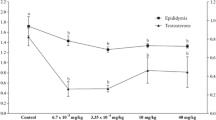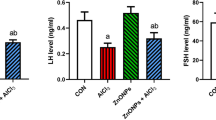Abstract
The aim of this study was to investigate the effects of aluminum (Al) exposure on the reproductive function in female rats. Forty female Wistar (5 weeks old) rats, weighing 110–120 g, were divided randomly into four groups. They were orally administrated with 0, 64.18, 128.36, and 256.72 mg aluminum chloride (AlCl3) per kilogram body weight in drinking water for 120 days. Levels of Al, estrogen (E2), progestogen (P), testosterone (T), follicle-stimulating hormone (FSH), and luteinizing hormone (LH) in serum were measured at the end of experiment. The results showed that levels of E2, P, FSH, and LH were significantly lower and Al concentration was significantly higher in all three Al-treated groups than those in the control group (GC). The level of T was significantly higher in the low- and medium-dose groups (GL and GM) (P < 0.05) but not in high-dose group (GH) compared with GC. The results suggest that the reproductive function of female rats is inhibited under long-term Al exposure in an Al dose-dependent manner.





Similar content being viewed by others
References
Rengel Z (2004) Aluminium cycling in the soil–plant–animal–human continuum. Biometals 17:669–689
Varner JA, Jensen KF, Horvath W, Isaacson RL (1998) Chronic administration of aluminum–fluoride or sodium–fluoride to rats in drinking water: alterations in neuronal and cerebrovascular integrity. Brain Res 784:284–298
Murphy EJ, Roberts E, Anderson DK, Horrocks LA (1993) Cytotoxicity of aluminum silicates in primary neuronal cultures. Neuroscience 57:483–490
Alexandra T, Eugenia D, Diana B, Snejana P (2010) The consequences of aluminium sulphate intake on exposure and integrity biomarkers in female rats at sexual maturity (two generation study). HVM Bioflux 2:11–18
Colomina MT, Roig JL, Torrente M, Vicens P, Domingo JL (2005) Concurrent exposure to aluminum and stress during pregnancy in rats: Effects on postnatal development and behavior of the offspring. Neurotoxicol Teratol 27:565–574
Zhang LC, Li XW, Gu QY, Zhu YZ, Zhao HS, Li YF, Zhang ZG (2010) Effects of subchronic aluminum exposure on serum concentrations of iron and iron-associated proteins in rats. Biol Trace Elem Res. doi:10.1007/s12011-010-8725-y
He QF, Li YJ, You LL, Zhang WC (2009) Study on productive endocrine system toxicity of subchronic cadmium exposure in female rats. Journal of Tianjin Agricultural University 16:11–13
Fan JJ (2008) A rapid graphite furnace atomic absorption spectrometric method for the determination of aluminum and Nie in food. HN Sci 26:35–38
Guo CH, Lu YF, Hsu G-SW (2005) The influence of aluminum exposure on male reproduction and offspring in mice. Environ Toxicol Pharmacol 20:135–141
Yousef MI, Kamel KI, El-Guendi MI, El-Demerdash FM (2007) An in vitro study on reproductive toxicity of aluminum chloride on rabbit sperm: the protective role of some antioxidants. Toxicology 239:213–223
Cherroret G, Desor D, Hutin MF, Burnel D, Capolaghi B, Lehr PR (1996) Effects of aluminum chloride on normal and uremic adult male rats. Tissue distribution, brain acetyltransferase activity, and some biological variables. Biol Trace Elem Res 54:43–53
Li XW, Hu CW, Zhu YZ, Sun H, Li YF, Zhang ZG (2010) Effects of aluminum exposure on bone mineral, density, mineral, and trace elements in rats. Biol Trace Elem Res. doi:10.1007/s12011-010-8861-4
Correia TG, Narcizo AM, Bianchini A, Moreira RG (2010) Aluminum as an endocrine disruptor in female Nile tilapia (Oreochromis niloticus). Comp Biochem Physiol C Toxicol Pharmacol 151:461–466
Da Silva FT, De Bittencourt BF, Sampaio FJ, Da Fonte RC (2010) Effects of maternal undernutrition during lactation on estrogen and androgen receptor expressions in rat ovary at puberty. Nutrition 26:993–999
Goldenberg RL, Vaitukaitis JL, Ross GT (1972) Estrogen and follicle stimulation hormone interactions on follicle growth in rats. Endocrinology 90:1492–1498
Welsh TH Jr, Zhuang LZ, Hsueh AJ (1983) Estrogen augmentation of gonadotropin-stimulated progestin biosynthesis in cultured rat granulosa cells. Endocrinology 112:1916–1924
Roberts AJ, Skinner MK (1990) Estrogen regulation of thecal cell steroidogenesis and differentiation: thecal cell-granulosa cell interactions. Mol Endocrinol 127:2918–2929
Robker RL, Richards JS (1998) Hormone-induced proliferation and differentiation of granulosa cells: a coordinated balance of the cell cycle regulators cyclin D2 and p27Kip1. Mol Endocrinol 12:924–940
Robker RL, Richards JS (1998) Hormonal control of the cell cycle in ovarian cells: proliferation versus differentiation. Biol Reprod 59:476–482
Drummond AE, Findlay JK (1999) The role of estrogen in folliculogenesis. Mol Cell Endocrinol 151:57–64
Kumar TR, Wang Y, Lu N, Matzuk MM (1997) Follicle stimulating hormone is required for ovarian follicle maturation but not male fertility. Nat Genet 15:201–204
Abel MH, Wootton AN, Wilkins V, Huhtaniemi I, Knight PG, Charlton HM (2000) The effect of a null mutation in the follicle-stimulating hormone receptor gene on mouse reproduction. Endocrinology 141:1795–1803
Rao CV (2001) Multiple novel roles of luteinizing hormone. Fertil Steril 76:1097–1100
Campbell BK, Scaramuzzi RJ, Webb R (1995) Control of antral follicle development and selection in sheep and cattle. J Reprod Fertil Suppl 49:335–350
Hunter MG, Robinson RS, Mann GE, Webb R (2004) Endocrine and paracrine control of follicular development and ovulation rate in farm species. Anim Reprod Sci 82–83:461–477
Niswender GD, Juengel JL, Silva PJ, Rollyson MK, McIntush EW (2000) Mechanisms controlling the function and life span of the corpus luteum. Physiol Rev 80:1–29
Liu YX, Hsueh AJ (1986) Synergism between granulose and theca interstitial cells in estrogen biosynthesis by gonadotropin-treated rat ovaries: studies on the two-cell, two-gonadotropin hypothesis using steroid antisera. Biol Reprod 35:27–36
Sterneck E, Tessarollo L, Johnson PF (1997) An essential role for C/EBP beta in female reproduction. Genes Dev 11:2153–2162
Alexandra T, Eugenia D, Muselin F (2008) The consequences of chronic aluminum sulphate intake on exposure and morphological integrity biomarkers (aluminum level and weight of sexual organs) in female rats. Lucrări Ştiintifice Medicină Veterinară 41:981–985
Chinoy NJ, Patel NT (2001) Effects of sodium fluoride and aluminum chloride on ovary and uterus of mice and their reversal by some antidotes. Fluoride 34:9–20
Zhang W, Pang F, Huang Y, Yan P, Lin W (2008) Cadmium exerts toxic effects on ovarian steroid hormone release in rats. Toxicol Lett 182:18–23
Richards JS, Ireland JJ, Rao MC, Bernath GA, Midgley AR Jr, Reichert LE Jr (1976) Ovarian follicular development in the rat: hormone receptor regulation by estradiol, follicle stimulating hormone and luteinizing hormone. Endocrinology 99:1562–1570
Wang C, Hsueh AJ, Erickson GF (1981) LH stimulation of estrogen secretion by cultured rat granulosa cells. Mol Cell Endocrinol 24:17–28
Wang C, Hsueh AJ, Erickson GF (1982) The role of cyclic AMP in the induction of estrogen and progestin synthesis in cultured granulosa cells. Mol Cell Endocrinol 25:73–83
Acknowledgments
This study was supported by a grant from the Science and Technology Program of Heilongjiang Educational Bureau (12511028).
Author information
Authors and Affiliations
Corresponding author
Rights and permissions
About this article
Cite this article
Wang, N., She, Y., Zhu, Y. et al. Effects of Subchronic Aluminum Exposure on the Reproductive Function in Female Rats. Biol Trace Elem Res 145, 382–387 (2012). https://doi.org/10.1007/s12011-011-9200-0
Received:
Accepted:
Published:
Issue Date:
DOI: https://doi.org/10.1007/s12011-011-9200-0




